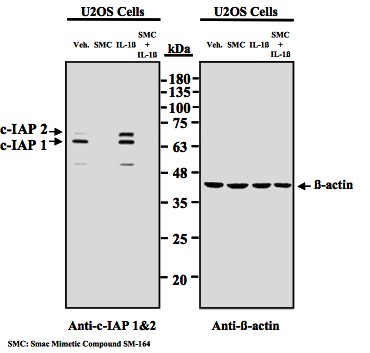anti-cIAP 1and 2
| Code | Size | Price |
|---|
| MBL-CY-P1041 | 100 ug | £339.00 |
Quantity:
Prices exclude any Taxes / VAT
Overview
Host Type: Rabbit
Antibody Isotype: IgG
Antibody Clonality: Polyclonal
Regulatory Status: RUO
Target Species:
- Human
- Mouse
- Rat
Application: Western Blot (WB)
Shipping:
4°C
Storage:
-20°C
Images
Documents
Further Information
Applications:
WB - 0.5 - 2 ug/ml.
Background:
The cellular inhibitor of apoptosis 1 and 2 (c-IAP1 and c-IAP2) proteins were identified based on their homology to a family of viral and cellular IAP proteins known to bind to caspases and inhibit their activity (1). Both cIAP1 and cIAP2 contain three characteristic baculovirus IAP repeat domains that facilitate binding to caspases and other proteins (2, 3). In addition, they contain a caspase recruitment domain of unknown function and a RING finger domain that functions as an E3 ubiquitin ligase (4). The precise biologic roles of c-IAP1 and c-IAP2 are currently not known. Biochemical data have indicated that c-IAP1 and c-IAP2, initially thought to be caspase inhibitors (2), can bind to caspases but do not directly inhibit them (5). Instead, recent studies show c-IAP1 and c-IAP2 regulate TNF alpha -mediated NF-kappa B signaling and are required to protect cells against and TNF alpha - and Interleukin-1 beta -induced apoptosis (6-9).
Concentration:
1.0 mg/mL
Formulation:
Supplied in 20mM phosphatase buffer (pH 7.5), 300mM NaCl, 50% glycerol.
Immunogen Translated:
Recombinant Ratfull length c-IAP1
MW:
63-68 kDa
Source:
This polyclonal antibody is produced by immunizing rabbit with recombinant c-IAP1, corresponding full length of Rat c-IAP1, expressed in E. coli. IgG is purified by antigen-affinity chromatography.
Target:
cIAP 1 and 2
References
1. Liston P, et al. (1996) Suppression of apoptosis in mammalian cells by NAIP and a related family of IAP genes. Nature 379:349?353.
2. Roy N, Deveraux QL, Takahashi R, Salvesen GS, Reed JC (1997) The c-IAP-1 and c-IAP-2 proteins are direct inhibitors of specific caspases. EMBO J 16:6914?6925. 3. Samuel T, et al. (2006) Distinct BIR domains of cIAP1 mediate binding to and ubiquitination of tumor necrosis factor receptor-associated factor 2 and second mitochondrial activator of caspases. J Biol Chem 281:1080?1090.
4. Yang Y, Fang S, Jensen JP, Weissman AM, Ashwell JD (2000) Ubiquitin protein ligase activity of IAPs and their degradation in proteasomes in response to apoptotic stimuli. Science 288:874?877.
5. Eckelman BP, Salvesen GS (2006) The human anti-apoptotic proteins cIAP1 and cIAP2 bind but do not inhibit caspases. J Biol Chem 281:3254?3260.
6. Vince JE, et al. (2007) IAP antagonists target cIAP1 to induce TNFalpha-dependent apoptosis. Cell 131:682?693.
7. Varfolomeev E, et al. (2007) IAP antagonists induce autoubiquitination of c-IAPs, NF-kappaB activation, and TNFalpha-dependent apoptosis. Cell 131:669?681.
8. Mahoney DJ, et al.(2008) Both cIAP1 and cIAP2 regulate TNF alpha-mediated NF-kappaB activation. Proc Natl Acad Sci U S A. 105:11778-83.
9. Cheung HH, et al.(2010) Smac mimetic compounds potentiate interleukin-1beta-mediated cell death. J Biol Chem. 285:40612-23.




